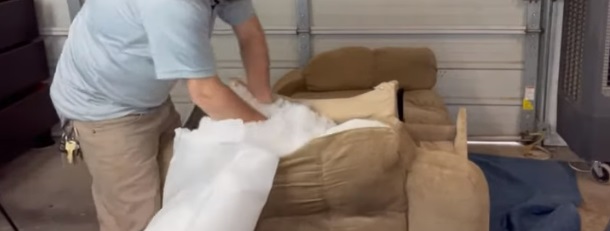A recliner is a comfortable piece of furniture that allows you to relax and unwind after a long day. However, over time, the padding on your recliner can wear out, causing discomfort and affecting your overall experience.
Adding new padding to your recliner is an easy and affordable way to restore its comfort and support, ensuring that it continues to be a cherished part of your home for years to come. One of the key benefits of adding padding to your recliner is improved comfort.
When you sit in a well-padded recliner, you’ll feel more relaxed and supported. This is especially true if you suffer from back pain or other health issues that require extra cushioning.
Good padding can help alleviate pressure points and distribute weight more evenly across the body, reducing strain on your joints and muscles. Additionally, by adding new padding, you can customize the firmness level according to your preferences – whether you prefer soft or firm cushions – so that every moment spent in the chair is pure bliss.
Read also: is it possible to change the fabric of a recliner
Assessing Your Recliner.
Before you start adding padding to your recliner, it’s important to assess the type of recliner you have and its current condition. This will not only help you determine the amount and type of padding needed, but also any repairs that may need attention.
The Type of Recliner You Have.
There are different types of recliners available in the market, and each one has a unique design that requires different measurements and padding needs. The most common types include rocker, glider, power lift, wall hugger, and push-back or manual recliners.
If you’re unsure about the type of recliner you own, check the manufacturer’s manual or look for identifying features such as a lever or button for reclining motion. Knowing your recliner’s model and brand can also help when choosing replacement cushions or seeking assistance from customer service.
The Condition of Existing Padding.
After identifying your reclining chair type, check if there’s existing padding or cushioning material that needs replacing. Over time and daily use, the foam or batting material can flatten out or tear apart leaving your chair uncomfortable for sitting.
To examine your current cushioning system thoroughly remove seat covers to inspect underlying materials. Use gloves if necessary to avoid contact with sharp objects like springs that might cause injuries during replacement.
Choosing Padding Materials.
Foam, Batting, or Memory Foam: Which is Best for Your Recliner?.
When it comes to adding padding to your recliner, there are three main materials you can choose from: foam, batting, and memory foam. Each material has its own pros and cons, and determining which one is best suited for your recliner depends on a variety of factors.
Foam is a popular option for adding padding to a recliner because it provides firm support. It comes in different densities and thicknesses so you can choose the perfect level of cushioning for your needs.
However, foam can be expensive compared to other materials like batting. It also tends to lose its shape over time with regular use.
Batting is another option that is commonly used as padding for recliners. It’s typically made of cotton or polyester fibers that are layered together for added comfort.
Batting is cost-effective and easy to work with since it can be cut down to size easily. However, it doesn’t provide as much support as foam does and may compress over time with extended use.
Memory foam offers the best of both worlds – comfort and support – making it an increasingly popular choice among homeowners who want the ultimate relaxing experience while lounging on their recliners. The material adapts well to body shape and heat which helps relieve pain points while sitting on the chair.
However, memory foam tends to be more expensive than other materials like batting but well worth considering if high-quality cushioning matters more than cost. Ultimately, when choosing a padding material for your recliner consider factors such as budget constraints, how often you’ll use the chair and whether durability or comfort matters most when selecting the right material for your project.
Measuring and Cutting Padding.
Adding padding to your recliner is a great way to enhance your comfort while relaxing at home, but it’s important to make sure you measure carefully to ensure a perfect fit. Before you start measuring, make sure that you remove any existing cushions or padding so that you have a clear view of the chair’s frame. You’ll need to measure both the seat and backrest cushions separately.
To measure the seat cushion, start by measuring its width from left to right and then its depth from front to back. Be sure to measure from the widest points of the seat and take note of these measurements so that you can cut your foam padding accordingly.
Next, measure the height of the backrest cushion by taking note of how high up the cushion extends on your recliner’s backrest. Now that you have all your measurements ready, it’s time to cut out your padding material for your specific recliner shape.
For this step, we recommend using foam padding as it is easy to work with and provides great support while sitting in your recliner. Use an electric carving knife or sharp scissors for cutting out foam pads.
Make sure you take extra care when working close around curves or corners – it helps if you trace an outline on paper beforehand so that you can visualize what needs trimming before actually cutting into the foam pad material itself. With these steps in mind, now it’s time to get started on adding new foam padding to enhance comfort level on top of frame or any existing cushioning present in your recliner!
Attaching Padding to Your Recliner.

What Method to Use?.
Once you have cut your padding materials, it is time to attach them to your recliner. There are a number of methods you can use, including Velcro strips and adhesive spray. The method you choose will depend on the type of padding material you are using, as well as personal preference.
Velcro strips are great if you want the option to remove the padding for cleaning or replacement down the line. Adhesive spray is more permanent and works well with foam padding.
Alignment and Placement Tips.
Ensure proper alignment and placement of the padding by using a measuring tape and marking where each piece should go before attaching it. You may also want to seek assistance from someone else to hold the recliner in place while you attach the padding materials.
When attaching foam or batting, start at one end of your recliner and work your way towards the other end along one side. Once that side is complete move onto another side until all sides are done.
When using adhesive spray, apply it evenly over both surfaces – the recliner’s fabric and padded material – then wait 30 seconds before pressing them together firmly for maximum bonding power. Don’t forget about armrests!
Make sure they also receive adequate padding for ultimate comfort during those movie marathons! By following these tips, your newly padded recliner will be comfortable enough for long hours of sitting enjoyment!
Additional Tips and Tricks.
Maintaining Your Newly Padded Recliner.
Now that your recliner has extra padding, you want to make sure it stays clean and fluffy. One easy way to do this is to vacuum the padding regularly with an upholstery attachment.
This will remove any dust or debris that may have settled on the surface. If you spill something on your newly padded recliner, make sure to blot it up immediately with a clean, absorbent cloth.
To keep the padding looking and feeling its best, give it a good fluffing every few weeks. This will help redistribute the filling and prevent it from getting too compressed in certain areas over time.
If you have a foam-based padding material, consider removing it from the recliner and letting it air out for a day or two every few months. This can help reduce any odor or moisture buildup.
Customizing Your Padded Recliner Further.
Adding decorative pillows is an easy way to customize your newly padded recliner further. Consider choosing pillows that complement the color of your recliner and add personality to your space. You could also opt for pillows with different textures or patterns to create visual interest.
If you want even more customization options, consider adding a slipcover over your padded recliner. Slipcovers come in many different materials and styles, allowing you to change up the look of your recliner whenever you’d like without committing to new upholstery.
Conclusion.
Adding padding to a recliner is an easy way to improve its comfort and support while also extending its lifespan. By assessing your existing furniture, choosing high-quality materials for padding, measuring carefully before cutting, attaching securely with adhesive spray or Velcro strips, maintaining cleanliness through regular vacuuming/fluffing/cleaning sessions as well as customizing further with decorative pillows or slipcovers – you can take pride in your newly padded recliner.
So why not give it a try? Your body will thank you.

Author: Saleh Ibrahim